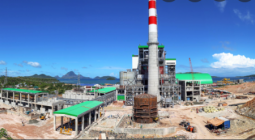Dangerous work and low salaries drive foresters in the Philippines away

One of the most dangerous countries for environmental defenders, the Philippines is seeing a concerning fall in interest for forestry training.
Forester Nick Manlisis recalls an incident in 2015, when he and a colleague encountered people logging illegally in a protected area 75 km south of the Philippine capital Manila. As they were leaving the forest with chainsaws they had seized from the loggers, a group from the local community surrounded their vehicles. “A few individuals even blocked our vehicles, preventing us from departing the area,” Manlisis says.
The pair spoke calmly to the group, stating that they were simply doing their jobs, and eventually managed to leave safely with the seized chainsaws. “The situation is delicate; any misstep on our part could lead to them becoming hostile and posing a serious threat to our safety.”
Manlisis says that scenarios like this, of intimidation and threats of violence against environmental conservators trying to stop illegal exploitation of forest resources, is one that he and other forestry professionals in the Philippines often face in their line of work.
In 2021, the Philippines was ranked the fifth most dangerous country in the world for land environmental defenders, and the worst in Asia, in an analysis by the NGO Global Witness. Between 2012 and 2021, 270 environmental defenders were killed in the country, of which more than 40 per cent were Indigenous people.
While over 80 per cent of the killings were linked to protests by environmental defenders against company operations, government workers face similar threats in their work. Another Global Witness report showed that in 2019, of the 19 state officials who were killed worldwide while engaged in environmental protection, including park rangers, eight were from the Philippines.
A combination of these security issues, declining interest in forestry studies and low salaries has seen forester numbers fall in the Philippines. Experts say this is causing the nation’s precious forest resources to go unprotected.
A tough profession declining in popularity
“The pursuit of becoming a forester is embraced by only a limited group of genuinely committed individuals,” says Rogelio Andrada II, deputy director of the Makiling Center for Mountain Ecosystems at the University of the Philippines Los Baños (UPLB).
Despite around 70 universities and colleges offering forestry degrees in the Philippines, it is a relatively unpopular field of study, Andrada says, citing the “undeniably challenging” nature of the profession.
If you compare the responsibility and duties of a forest[ry professional] against the compensation they are receiving, it is really not sufficient, especially for forest rangers.
Rogelio Andrada II, deputy director, Makiling Center for Mountain Ecosystems - University of the Philippines Los Baños
To become a licensed forester in the Philippines, one needs to pass a nationwide exam, which only graduates of forestry degrees can sit. Licensed foresters are expected to have a broad knowledge of forest ecosystems, as well as policy and governance, forest engineering, and forest resource management. The profession includes forest technicians, who conduct field research and collect data, as well as rangers, who are primarily focused on forest protection.
According to data from the Society of Philippines Foresters (SPF), as of 2021, the country had only around 14,000 registered foresters for approximately 7.2 million hectares of forest area. That equates to one licensed forester for every 514 hectares.
There are only 10 forest technicians working in the 4,244-hectare Mount Makiling Forest Reserve, located 65 km south of Manila and administered by UPLB for use in training forestry students, notes Willie Abasolo, president of the Philippine Forestry Education Network, part of the Society of Filipino Foresters. “I think that [this scarcity of foresters] is also true [of] other parts of the country,” he adds.
That scarcity is threatening to get even more severe. In the last five years, some forestry schools in the Philippines have been experiencing a fall in enrolment. The UPLB’s College of Forestry and Natural Resources (CFNR), one of the country’s leading schools for the subject, has seen a sharp decline in student numbers – from 219 in 2018 to a five-year low of 171 in 2022, based on records collected by the Office of the CFNR College Secretary.
“It’s a bleak scenario… we don’t have enough groups of people who would take care of reforestation, preservation, and utilisation of our forests,” says Andrada.
For years, university forestry faculties such as CFNR have been attempting to increase interest in the field through eco-school projects and youth summer programmes that encourage young people to appreciate conservation.
The effects of low pay and dangerous work
Alongside a shortage of personnel and security concerns, the forestry sector in the Philippines is also grappling with the effects of low salaries. Foresters engaged in research work, which requires degree-level knowledge, receive an average monthly salary of 22,000 to 24,000 Philippine pesos (US$395-431), according to Andrada. That’s just over double the average minimum wage in Manila.
“If you compare the responsibility and duties of a forest[ry professional] against the compensation they are receiving, it is really not sufficient, especially for forest rangers,” Andrada says. “Their salary is low even though their tasks are difficult.” Although forest rangers don’t have to have a forestry degree, they engage in on-the-ground work that is laborious and fraught with danger, such as conducting surveillance, containing forest fires and confronting those engaged in illegal resource exploitation.
Meanwhile, Andrada observes that foresters from the Philippines who go abroad for further study tend not to return home if they can find better opportunities elsewhere – namely, forestry jobs that pay more and are based in less dangerous areas.
Dangers to foresters and forests
A lack of foresters brings serious risks to the forests of the Philippines, which are home to thousands of species that live nowhere else on earth. Without surveillance and enforcement of restrictions, illegal activities that threaten such biodiversity can flourish undetected.
This has been exacerbated in recent years by laws that benefit large-scale exploitation of natural resources in the Philippines. In late 2021, then-president Rodrigo Duterte ended a ban on open-pit mining and resumed the issuing of new mining agreements. The policy shift saw some applications for mining permits target protected forest areas. Despite the subsequent administration under Bongbong Marcos insisting that “all our forest cover is important and must remain”, the new president has not retracted the mining policy.
These laws create further complications for foresters, given many of the challenges they face derive ultimately from their employer: the government. Andrada suggests that this makes accountability non-existent. “Most of the people who own big businesses and those [that] extract forest resources like water and timber are owned by politicians and private companies,” he says.
Global Witness notes in its report on slain environmental defenders that in the Philippines, “it is suspected that state forces are behind the majority of killings in the few cases where the identity of the perpetrators is documented.”
As Manlisis’ ordeal proved, forestry professionals are often met with hostility when doing their jobs. But Andrada says that the work is not about punishing users of forest resources, rather simply ensuring they are extracting in a fair and sustainable manner. “Since forests have no fences, designated protected areas should be regularly guarded to monitor who utilises natural resources… up to what extent their utilisation is, and how people get the products they intend to use,” he says.
This is especially the case for small-scale extraction of resources to meet basic needs, he notes, such as obtaining wood for stove cooking that the mostly Indigenous population of the Philippine uplands engage in. Ultimately, he says, “We do not ban people from using the resources, but when they do, they should harness resources [fairly], in a way that is not destructive” to the environment.
The Department of Environment and Natural Resources said in an email interview that “encouraging foresters to continue leading the purpose of protecting our forests and forest lands despite attacks and threats requires a multi-faceted approach that addresses their safety, provides support systems, and fosters a sense of purpose and commitment.”
The department added that strategies to deal with these issues include strengthening legal protection of foresters from threats and attacks; raising public awareness of the importance of forestry; providing insurance to foresters; conducting risk assessments; and developing contingency plans to mitigate potential threats.






